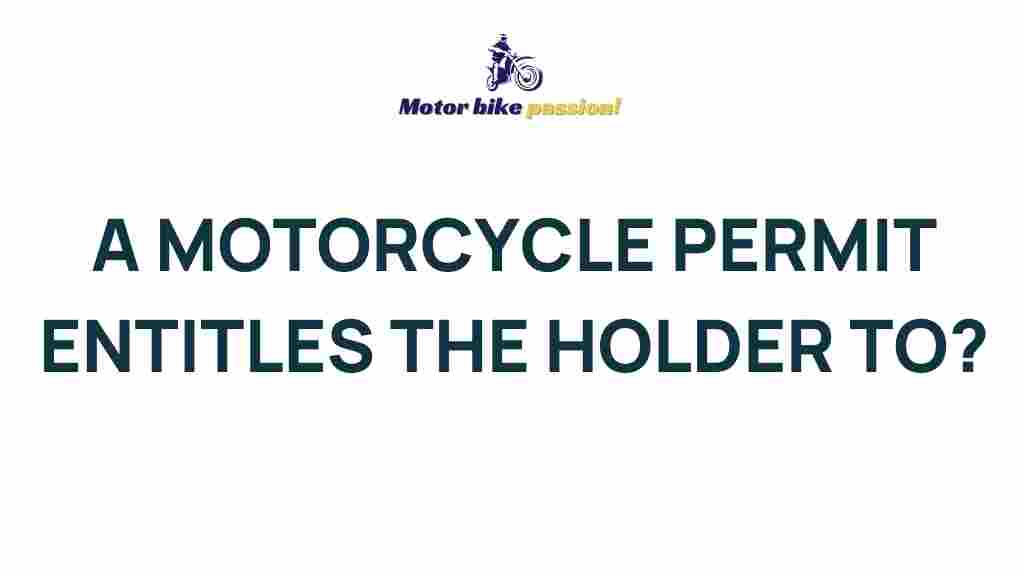Uncover the Secret World of Motorcycle Permits
Are you fascinated by the thrill of riding a motorcycle? Whether you’re a seasoned rider or a newcomer, understanding the motorcycle permit process is crucial for enjoying all the privileges that come with it. This article will guide you through the essential regulations, eligibility criteria, licensing requirements, and restrictions associated with obtaining a motorcycle permit. So, let’s dive into this exciting world!
Understanding Motorcycle Permits
A motorcycle permit is a legal authorization granted by the state that allows you to operate a motorcycle on public roads. However, the rules surrounding motorcycle permits can vary significantly from one location to another, making it essential to familiarize yourself with your particular state’s laws.
Eligibility Requirements for a Motorcycle Permit
Before you can obtain a motorcycle permit, you must meet certain eligibility requirements. These requirements generally include:
- Age: Most states require you to be at least 16 years old to apply for a motorcycle permit.
- Driver’s License: You may need a valid driver’s license or a learner’s permit before applying for a motorcycle permit.
- Written Test: Passing a written test on motorcycle laws and safety is often necessary.
- Vision Test: A vision screening may be conducted to ensure you can see well enough to safely operate a motorcycle.
Steps to Obtain a Motorcycle Permit
Here’s a step-by-step guide to help you navigate the process of obtaining your motorcycle permit:
Step 1: Research Your State’s Regulations
Each state has its own specific rules regarding motorcycle permits. Start by visiting your state’s Department of Motor Vehicles (DMV) website to understand the local regulations, eligibility, and required documents. You can usually find all the necessary information on the DMV website.
Step 2: Prepare for the Written Test
Once you are familiar with the regulations, it’s time to prepare for the written test. Study your state’s motorcycle operator manual, which covers essential topics such as:
- Traffic laws specific to motorcycles
- Safe riding practices
- Motorcycle handling techniques
Consider taking a motorcycle safety course, which can often provide you with valuable knowledge and skills.
Step 3: Take the Written Test
Head to your local DMV office and take the written test. Make sure to bring the necessary documents, such as:
- A valid ID
- Proof of residency
- Any required fees
Upon passing the written test, you will receive your motorcycle permit, allowing you to start practicing your riding skills.
Step 4: Practice Riding with Restrictions
With your motorcycle permit in hand, you can begin riding, but be aware of the restrictions that may apply. Common restrictions include:
- Riding only during daylight hours
- No passengers allowed
- No riding on highways or interstates
Always carry your permit while riding and adhere to all restrictions to avoid penalties.
Step 5: Complete Additional Training
It’s highly recommended to complete an approved motorcycle safety course. Many states offer these courses, which can enhance your riding skills and may even reduce your insurance premiums. Completing such a course can also sometimes exempt you from the road test when you apply for your full motorcycle license.
Transitioning from a Motorcycle Permit to a Full License
After gaining sufficient riding experience under your permit, you may be ready to apply for a full motorcycle license. The process typically involves:
- Meeting the minimum holding period for the permit.
- Passing a skills test or completing a motorcycle safety course.
- Paying the required fees.
Check your state’s DMV website for specific details on the transition from a motorcycle permit to a full license.
Common Troubleshooting Tips
While navigating the motorcycle permit process, you may run into some common issues. Here are some troubleshooting tips to help you:
- Missing Documents: Double-check that you have all required documents before heading to the DMV.
- Failed Written Test: If you don’t pass the written test, review the material and retake it after a waiting period.
- Riding Restrictions Confusion: Always clarify any doubts regarding restrictions by contacting your local DMV.
Understanding the Laws and Restrictions
Familiarizing yourself with the laws regarding motorcycle permits and licenses is crucial for safe riding. Some additional laws and restrictions include:
- Helmet laws: Many states require all riders to wear helmets.
- Insurance requirements: Most states mandate that you carry a minimum amount of motorcycle insurance.
- Road usage laws: Some areas may have specific laws regarding where motorcycles can operate.
Staying informed about these laws will help you avoid legal issues and enhance your riding experience.
Privileges of Having a Motorcycle Permit
Holding a motorcycle permit allows you to enjoy numerous privileges, including:
- Gaining experience on a motorcycle under controlled conditions.
- Participating in motorcycle safety courses to improve your skills.
- Getting accustomed to operating a motorcycle before obtaining a full license.
These privileges are invaluable as they prepare you for the responsibilities that come with full motorcycle licensing.
Conclusion
Obtaining a motorcycle permit is an exciting step towards enjoying the freedom of the open road. By understanding the eligibility requirements, navigating through the regulations, and adhering to laws and restrictions, you’ll be well on your way to becoming a responsible rider. Remember to take advantage of the privileges that come with your permit, practice safe riding, and always stay informed about the changing laws in your state.
For more information on motorcycle safety courses near you, check out this resource. Happy riding!
This article is in the category Basic Guides and created by MotorBikePassion Team
